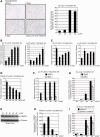The arginine methyltransferase PRMT6 regulates cell proliferation and senescence through transcriptional repression of tumor suppressor genes
- PMID: 22904088
- PMCID: PMC3479209
- DOI: 10.1093/nar/gks767
The arginine methyltransferase PRMT6 regulates cell proliferation and senescence through transcriptional repression of tumor suppressor genes
Abstract
The protein arginine methyltransferase 6 (PRMT6) is a coregulator of gene expression and executes its repressing as well as activating function by asymmetric dimethylation of histone H3 at R2 (H3 R2me2a). Given that elevated expression levels of PRMT6 have been reported in various cancer types, we explore here its role in cell proliferation and senescence. We find that knockdown of PRMT6 results in proliferation defects of transformed as well as non-transformed cells, causes G1-phase arrest and induces senescence. This phenotype is accompanied by transcriptional upregulation of important cell cycle regulators, most prominently the cyclin-dependent kinase (CDK) inhibitor gene p21 (p21(CIP1/WAF1), CDKN1A) and p16 (p16(INK4A), CDKN2A). Chromatin immuno-precipitation analysis reveals that the p21 gene is a direct target of PRMT6 and the corresponding histone mark H3 R2me2a. Using a cell model of oncogene-induced senescence (OIS), in which p21 is an essential activator of the senescent phenotype, we show that PRMT6 expression declines upon induction of senescence and conversely p21 gene expression increases. Moreover, overexpression of PRMT6 leads to reduced levels of OIS. These findings indicate that the transcriptional repressor activity of PRMT6 facilitates cell proliferation and blocks senescence by regulation of tumor suppressor genes and that this might contribute to the oncogenic capacity of PRMT6.
Figures





Similar articles
-
p53-Independent regulation of p21Waf1/Cip1 expression and senescence by PRMT6.Nucleic Acids Res. 2012 Oct;40(19):9534-42. doi: 10.1093/nar/gks858. Epub 2012 Sep 16. Nucleic Acids Res. 2012. PMID: 22987071 Free PMC article.
-
Ablation of PRMT6 reveals a role as a negative transcriptional regulator of the p53 tumor suppressor.Nucleic Acids Res. 2012 Oct;40(19):9513-21. doi: 10.1093/nar/gks764. Epub 2012 Aug 16. Nucleic Acids Res. 2012. PMID: 22904064 Free PMC article.
-
Cell cycle regulation by the PRMT6 arginine methyltransferase through repression of cyclin-dependent kinase inhibitors.PLoS One. 2012;7(8):e41446. doi: 10.1371/journal.pone.0041446. Epub 2012 Aug 20. PLoS One. 2012. PMID: 22916108 Free PMC article.
-
Transcriptional Regulation of the p16 Tumor Suppressor Gene.Anticancer Res. 2015 Aug;35(8):4397-401. Anticancer Res. 2015. PMID: 26168478 Review.
-
The Emerging Role of PRMT6 in Cancer.Front Oncol. 2022 Mar 4;12:841381. doi: 10.3389/fonc.2022.841381. eCollection 2022. Front Oncol. 2022. PMID: 35311114 Free PMC article. Review.
Cited by
-
PRMT6 Epigenetically Drives Metabolic Switch from Fatty Acid Oxidation toward Glycolysis and Promotes Osteoclast Differentiation During Osteoporosis.Adv Sci (Weinh). 2024 Oct;11(40):e2403177. doi: 10.1002/advs.202403177. Epub 2024 Aug 9. Adv Sci (Weinh). 2024. PMID: 39120025 Free PMC article.
-
Optineurin downregulation induces endoplasmic reticulum stress, chaperone-mediated autophagy, and apoptosis in pancreatic cancer cells.Cell Death Discov. 2019 Aug 9;5:128. doi: 10.1038/s41420-019-0206-2. eCollection 2019. Cell Death Discov. 2019. PMID: 31428460 Free PMC article.
-
Protein Arginine Methyltransferase 6 (Prmt6) Is Essential for Early Zebrafish Development through the Direct Suppression of gadd45αa Stress Sensor Gene.J Biol Chem. 2016 Jan 1;291(1):402-12. doi: 10.1074/jbc.M115.666347. Epub 2015 Oct 20. J Biol Chem. 2016. PMID: 26487724 Free PMC article.
-
Protein arginine methyltransferase 6 controls erythroid gene expression and differentiation of human CD34+ progenitor cells.Haematologica. 2018 Jan;103(1):18-29. doi: 10.3324/haematol.2017.174516. Epub 2017 Oct 12. Haematologica. 2018. PMID: 29025910 Free PMC article.
-
Structural basis of arginine asymmetrical dimethylation by PRMT6.Biochem J. 2016 Oct 1;473(19):3049-63. doi: 10.1042/BCJ20160537. Epub 2016 Aug 1. Biochem J. 2016. PMID: 27480107 Free PMC article.
References
-
- Frankel A, Yadav N, Lee J, Branscombe TL, Clarke S, Bedford MT. The novel human protein arginine N-methyltransferase PRMT6 is a nuclear enzyme displaying unique substrate specificity. J. Biol. Chem. 2002;277:3537–3543. - PubMed
-
- Lakowski TM, Frankel A. A kinetic study of human protein arginine N-methyltransferase 6 reveals a distributive mechanism. J. Biol. Chem. 2008;283:10015–10025. - PubMed
Publication types
MeSH terms
Substances
LinkOut - more resources
Full Text Sources
Miscellaneous

